One Nation, One Charger: Govt Wants One Universal Charger For All Mobiles, Laptops, & Gadgets!
The government is forming expert committees to explore the use of universal chargers for mobile phones and other portable electronic devices.

Following that, a complete report is expected to be submitted in two months.
They must consider clubbing electronic devices based on power requirements.
So, laptops could be a separate class from smartphones, harmonising charging speeds, and giving consumers the choice of buying devices with or without chargers, bringing down cost.
Contents
Tackling e-waste
The government seeks to implement the ‘Common Charger Policy’ which is also known as ‘One Nation One Charger’.
Under this policy all digital devices such as smartphones, laptops, tablets, and other wearable devices will have a standard or universal charger.
If successfully implemented, it will help minimize e-Waste issues on a larger scale.
Urban homes have 10 to 14 unused chargers lying around, which create a lot of waste.
India had 22,700 tonnes of e-waste in FY17, but that figure has surged to a staggering 350,000 tonnes in FY21.
Consumer benefits
But mostly it is the public that will benefit, since they will no longer have to carry multiple chargers for various gadgets.
They can also save money since phones will get cheaper as manufacturers won’t have to pack a new charger alongside it.
The EU which has adopted a similar plan believes that this could help consumers save up to €250 million a year.
EU example
However, there is also a need to identify and address difficulties that may emerge due to consolidating charging options, allowing for an effective and efficient change without hindering technical progress.
India might be following the European Union’s lead.
In June EU officials inked a provisional agreement that requires a uniform charging cord in the 27-nation bloc as part of a wider effort to make products sold in the EU more sustainable and cut down on electronic waste.
In 2 years, the USB Type-C will become the common charging port for all mobile phones, tablets and cameras across the bloc, including the likes of Apple.
Manufacturers protest
Manufacturers have expressed concerns that this move may hurt innovation.
They also have vested interests, since a common charger will force them to ditch their proprietary technology.
As a result they will no longer have bragging rights for fast-charging capabilities.
Apple hit hard
Apple in particular would be impacted, same as in the EU’s case.
Its iPhones still use the Lighting port for charging, and this requires a different cable compared to most other Android phones in the market.
Samsung, Xiaomi, Oppo, Vivo, and Realme — the top five brands in the Indian smartphone market have all switched to Type-C charging ports.
While the charging speeds of each device may differ, given that most have a Type-C port at the bottom, the chargers can be used interchangeably.

[…] USB-C.There also has been news that the “Common Charger Policy,” also known as “One Nation One Charger,” is something the government wants to put into practice.All digital devices, including […]
[…] also has been news that the “Common Charger Policy,” also known as “One Nation One Charger,” is something the government wants to put into […]